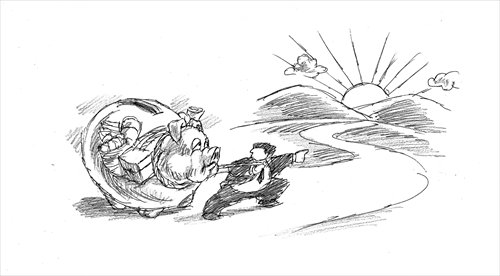Accelerating reforms is the only way to cope with TPP
China needs to repeat 1990s determination before it joined the WTO

Illustration: Peter C. Espina/GT
After five years of talks, the US and 11 other Pacific Rim countries finally sealed a deal on the Trans-Pacific Partnership (TPP) on Tuesday in Atlanta. The free trade pact will significantly reduce barriers to trading goods and services between member countries and create new business rules for the economies which represent 40 percent of the global GDP. The TPP, which excluded China, poses a serious challenge to the county. The challenge may not come from the impact of a possible loss of around $100 billion in trade the pact may bring to China, but rather the rules which target China's Achilles heel. As a result China will feel constrained in its future economic engagements with the world, and the trade landscape for China will be bumpy.
Specifically, compared with other free trade agreements, the TPP is unique. The challenges it imposes on China are reflected in the following aspects. First, TPP establishes for the first time the Investor-State Dispute Settlement (ISDS) mechanism under the multilateral framework. In contrast to the WTO, which boasts of a trade settlement mechanism, an investor protection mechanism is absent. The ISDS allows transnational companies to sue TPP member countries. That means companies can claim compensation from the member states for any loss resulting from the change of policy in these countries by using these legal tools. It will significantly protect the safety of overseas investments but also poses a challenge to the sovereignty of member states.
Second, the TPP successfully sets up rules for the cross-border operations of state-owned enterprises (SOEs). The US has always believed China has been gaining unfair advantage by offering subsidies to its SOEs, and Chinese SOEs expand aggressively around the world by relying on government support, which is the root cause of the disruption in the world economic order. TPP for the first time made a comprehensive response to the market behavior of SOEs - it demands that member states privatize their SOEs and requires SOEs to completely follow market rules. That means Chinese SOEs may face restrictions in their international operations in the future.
Third, the TPP also has strict provisions to protect labor rights and the environment. Member states are required to safeguard labor rights. For example, it requires Vietnam to allow the establishment of independent trade unions, and Malaysia to prohibit human trafficking. Moreover, the TPP asks member states to strictly protect the environment as they seek economic development. These provisions not only help enforce the US' image of protecting human rights but also ensures the TPP gains the moral high ground. But these provisions are unfavorable to China, which remains in the early stages of economic development. The economic competitiveness China has gained in the past was largely built upon low labor costs and at the expense of the environment. How to improve the treatment of China's labor force and protect the environment while not undermining the international competitiveness of Chinese firm will prove to be a huge test for China.
Fourth, the TPP has made yet another breakthrough in formulating a stricter regime for protecting intellectual property rights (IPR). The pact, if ratified, would exert a lot of pressure on China which has long been perceived as lacking sufficient IPR safeguards.
Many Chinese enterprises have long been accustomed to eking out a living by emulating or even copying others. And so China has blossomed into the world's top "copycat" kingdom. When the TPP comes into effect, these knockoff products will be completely locked out of the markets of the 12 member states, and enterprises relying on copycat products would consequently go bankrupt.
Fifth, the TPP also sets rules for the free exchange of information, posing a challenge to China's traditional mindset on information security that leads to information blocking. On top of that, the US-led TPP trade agreement will be a boon for negotiations between the US and European Union (EU) for another big trade deal - the Trans-Atlantic Trade and Investment Partnership (TTIP). There is a chance that TTIP negotiations would enter into a fast-track agreement. Meanwhile, Japan is also stepping up efforts to push Economic Partnership Agreement (EPA) negotiations. All of these signify that in the foreseeable future, the US, EU and Japan will jointly establish a giant market with unified rules. By contrast, China, as the world's second-largest economy, would be isolated from the unified market. This obviously will have a negative impact on China's economic growth.
Despite the pressure, China should not respond to the TPP deal with complaints and self-isolation, or simply launching into a wave of ideological tirades against the treaty, as a host of TPP rules, admittedly, represent the future trend of the world's economic development. What China has to do is to quicken the pace of negotiations for a global network of free trade agreements that include a bilateral investment treaty between China and the US. China also needs to muster the courage and determination, as it did in the 1990s prior to joining the WTO, to overcome obstacles erected by vested interests and accelerate its own reforms. Only in this way can China's economy bid a farewell, as quickly as possible, to primitive economic growth and shift toward a healthy growth path featuring a market economy under the rule of law.
The author is an associate professor of the School of International Studies at the Renmin University of China. He is also a research fellow at the National Academy of Development and Strategy at the Renmin University of China. bizopinion@globaltimes.com.cn